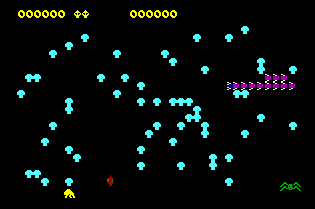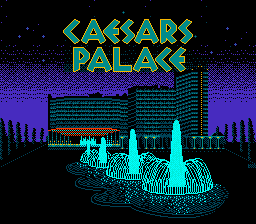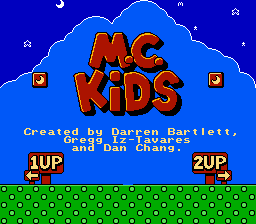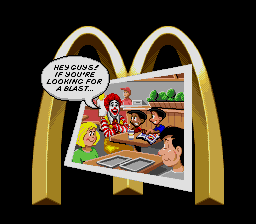
Welcome to the NES interview, a hopefully occasional installment in Special Features. Here we'll interview the people responsible for making the NES - and the video game world - what it is, from programmers to designers to those who found themselves simply swept up in the revolution. In this installment, |tsr interviews Gregg Tavares, a game programmer and designer who has been in the business for fifteen years. He's worked for Atari, MUSE Software, Microprose, Cinemaware, Virgin Games (where he worked on MC Kids and the unreleased Robocop vs. Terminator for NES), and Crystal Dynamics, where he was the lead programmer for Gex for the 3DO. He now runs Big Grub, his own software design house. Q: OK, give me some general information on yourself. How did you get started in your video life (heh)? What's your gameography?
A: I started programming in 8th grade. My friend Greg Marquez
had recently started learning to program. He showed me one of his first
programs and for some reason I thought it was really cool.
Of course we started by typing in programs from magazines. Although it
wasn't our purpose, typing in the programs meant that we started learning
how they worked. Especially when you made a typo and needed to find where
it was, it was better to kind of understand the code so you could better
guess where the problem might be instead of just comparing hundreds of lines
of code to the original printed in the magazine. Next we started modifying
those programs and also commercial programs (mostly games), doing things like
changing the graphics and the text to sillier things.
My father found my first commercial job. He saw an ad at his work saying
"programmers wanted". We called and the guy that answered wanted somebody
to convert Centipede from the Atari 800 to the Commodore 64. I can't believe
I accepted since I'd never done something that detailed. It took us 6 weeks
and we got paid $3000.00 I'm sure Atarisoft made millions on it.
A: I joined Virgin Games because I was completely broke and all my credit cards
were maxxed out and so I needed a paycheck immediately or I'd miss a payment
and my rent. My friend, Dan Chang, introduced me to his
boss, Graeme Devine and after the interview Graeme gave
me a job to do Caesars Palace for the GameBoy. Two weeks later he moved me
to a new project: Terminator for the NES. My friend Dan was doing M.C.
Kids and Darren Bartlett as doing the art for both projects.
After about 3
months Virgin decided they wanted both Dan and I to work on M.C.Kids and to
stop work on Terminator.
Q:Is this the same Terminator that was later released by Mindscape for the NES?
A:No, we never really did any real work on it.
At the time we were all very excited about both
projects. We felt we could make an awesome game. Even the big boss, Martin
Alper, caught our excitement and said he thought M.C.Kids would be the first
game he would actually play. (To this day he still brags that he's never
played a video game in his life. What an idiot. (see the Random Bits
section of www.atgp.com for details) Q: How long did MC Kids take to complete?
A: That depends on how you account it. Assuming we started in August it took
13 months. But, in August, Dan was writing a 6502 assembler and linker and
I was writing a sprite animation editor. Dan worked on the assembler/linker
until about February and then he was fired for not getting the game done.
That made me the only programmer. I continued to work on the sprite
animation editor until about late March. I was then wisely ordered to stop
working on tools and write the damn game. So, if you time it from there it
took about 6 months to write. Darren, the artist, had been doing some
design work before then though so I suppose you'd have to add a little more
time.
A: At the time I finished the game I was recently married. My wife's maiden
name was Izaguirre and when we married we agreed to become Mr. and Mrs.
Iz-Tavares. We were only married about another 11 months. In the "special
thanks" section of the credits you'll see "Izzy and Lizzie". Darren and
Lizzie are still together and have 2 kids.
Q: How much input (or supervision) did McDonald's Corp. give you
during the creation of the game? Were you relatively "free" in
what you could put in the game, or did McDonald's give you
strict guidelines?
A: The only major guidelines McDonald's Corp gave was that there should be
absolutely no food in the game. They didn't want it to be perceived as an
advertisement. The only other thing they changed was that originally the
main characters were named "M.C. Kid" (pronouced EmCee Kid) and "Micky D."
They told us those names were too "racist" and they changed the names to
Mick and Mack.
A: Yes, but it isn't as blatant like "if you eat three cheeseburgers you become
super powered up."
I kind of think that was a personal preference of our McDonald's contact
because David Perry says in Global Gladiators they specifically asked for
food and the restaurant to be put in.
Q: Why did McDonald's decide not to aggressively advertise MC
Kids themselves? Just about the only advertising I saw for it
was a 20-page strategy guide insert in Electronic Gaming
Monthly.
A: We don't really know. One of the things that originally excited us about
the game was that McDonald's was going to have a Happy Meal promotion. At
that time, McDonald's averaged selling 1 million Happy Meals a day. We
thought we couldn't lose. A couple of things happened. First, the game was 4
months late. It was supposed to be finished in June but was instead
finished in September. Another was that they didn't believe it was a good
game. The only thing McDonald's actually did was put a coupon for the game in a
Happy Meal.
There were some things that didn't make it in the game. For example the
original world maps looked very much like the map on Super Mario World. Nintendo saw the maps at the June CES and told us we were ripping
them off so we changed them. Also, originally there were 6 or 8 powerups.
When you completed a card you got the power up. We didn't have time to
implement any of them.
Q: What sort of power-ups were planned?
A: I don't really remember. I remember the design of the screen showing all
your cards. I'm sure they were things like super jump, super speed, flying
etc.
Q: Did you make any other NES works?
A: I made Robocop Vs. Terminator for Interplay.
It was a very very bad game. The artists on that game couldn't deal
well with the limits of the NES so it looks very bad and the designer was a
recently promoted playtester and he didn't really know what he was doing.
My attitude was that I would pretty much do what I was told (since I was
doing it as a contract) and so I didn't push any design issues.
At the time they told me it probably wouldn't ship in the United States but
it might ship in Europe. I didn't keep a working version of the source;
otherwise I thought about leaking it out on the net.
Q: Do you still keep in touch with the other MC Kids staff? What're
they doing these days?
A: Yes. Dan Chang is one of my best friends. He lives near Seattle,
Washington and works at Boss Game Studios. His last published game was
Spider for the PSX. Darren Bartlett is a partner in a the company
Illusions. They did Scooby Doo for the Genesis, Caesars Palace for SNES
and Genesis and Dragon Tails for the Saturn/PSX. Rene Boutin (another
artist from M.C. Kids) recently worked on the game Alien Rampage. Seth Mendelson (whose only contribution is the name
of the game and the original kids names) is currently at Origin.
Q: What's your favorite video game in general/NES game in
particular?
A: My favorite video games are
Q: What's your personal favorite video game memory, and what is
it that you like best about what you do?
A: Hmmm. I'm not sure I could think of a favorite video game memory. As far
as what I like best? Making video games is an art. I'm not trying to sound
all snobby. Instead I really mean that it is an art in the same way that
writing a book or making a movie is an art. The goal is to make a fun and
enjoyable and possibly moving experience. Most games fail at that. It's
not easy. When I know I'm working on something great it's one of the
coolest feelings. Unfortunately that's only happened for me about 3 times
in my career. |
 After that we started programming our own games. My friend, John, and I did
a game called Emerald Scepter for ourselves which was very much like
Adventure for the Atari 2600. It was my first 100% assembly langauge
game. I also wrote a game called Pit Viper. It was kind of a cross
between the Apple II game Snake Byte and the Atari 2600 game Surround.
It was also a four player game and we were actually addicted to it for about
a month.
After that we started programming our own games. My friend, John, and I did
a game called Emerald Scepter for ourselves which was very much like
Adventure for the Atari 2600. It was my first 100% assembly langauge
game. I also wrote a game called Pit Viper. It was kind of a cross
between the Apple II game Snake Byte and the Atari 2600 game Surround.
It was also a four player game and we were actually addicted to it for about
a month. Q: How did you originally get into the MC Kids project team? What
was it that interested you in the project?
Q: How did you originally get into the MC Kids project team? What
was it that interested you in the project? Q: Why are you listed as "Gregg Iz-Tavares" in the intro and
credits?
Q: Why are you listed as "Gregg Iz-Tavares" in the intro and
credits? Q: That's odd; like going around visiting Mcdonaldland characters and picking
up golden arches isn't advertisement? ;)
Q: That's odd; like going around visiting Mcdonaldland characters and picking
up golden arches isn't advertisement? ;)
